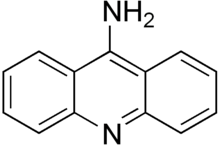9-Aminoacridine
9-Aminoacridine is a highly fluorescent dye used clinically as a topical antiseptic and experimentally as a mutagen, an intracellular pH indicator and a negative mode small molecule MALDI matrix.[1]
 | |
| Names | |
|---|---|
| IUPAC name
Acridin-9-amine | |
| Identifiers | |
CAS Number |
|
3D model (JSmol) |
|
| ChEBI | |
| ChEMBL | |
| ChemSpider | |
| ECHA InfoCard | 100.001.814 |
PubChem CID |
|
| UNII | |
CompTox Dashboard (EPA) |
|
InChI
| |
SMILES
| |
| Properties | |
Chemical formula |
C13H10N2 |
| Molar mass | 194.2319 g/mol |
| Appearance | Crystalline yellow |
| Melting point | 300 °C (572 °F; 573 K) |
| Pharmacology | |
ATC code |
D08AA02 (WHO) |
Except where otherwise noted, data are given for materials in their standard state (at 25 °C [77 °F], 100 kPa). | |
| Infobox references | |
See also
- 2-Aminoacridine
- 3-Aminoacridine
- 4-Aminoacridine
References
- Vermillion-Salsbury, Rachal L.; Hercules, David M. (13 June 2002). "9-Aminoacridine as a matrix for negative mode matrix-assisted laser desorption/ionization". Rapid Communications in Mass Spectrometry. Wiley Interscience. 16 (16): 1575–1581. doi:10.1002/rcm.750.
This article is issued from Wikipedia. The text is licensed under Creative Commons - Attribution - Sharealike. Additional terms may apply for the media files.